By Joan Doggrell
The Cathedral of St. Philip is beautiful and inspiring, and I wanted to know more about it. So I used my status as a St. Paul’s blog writer and requested a tour. Mr. Trammel Williams, Event and Calendar Coordinator at St. Philip’s, arranged for me to meet Mrs. Jean Morris, longtime member of the St. Philip’s parish and an expert on the cathedral. A retired seventh grade teacher, she has an educator’s reverence for knowledge and an incredible memory.
We met in the spacious atrium of St. Philip’s on a rainy Monday. Jean was sitting on a couch near a pile of gear belonging to a homeless man. He had come there to get out of the cold and rain as do many of Atlanta’s homeless, who find shelter in the hallways and recesses of this imposing structure.
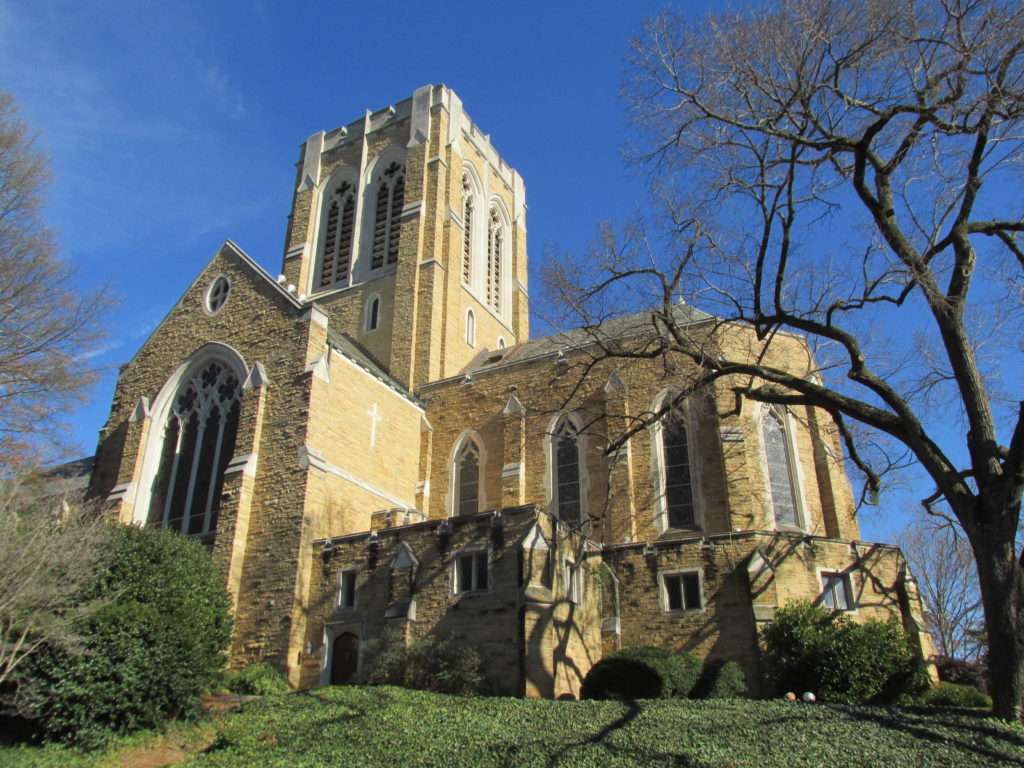 St. Philip’s Cathedral (from Wikipedia)
St. Philip’s Cathedral (from Wikipedia)
After introductions, I indicated that I was open to anything she would like to tell me. Jean decided that the history of St. Philip’s was a good place to start. Before launching into it, however, she stated emphatically that the cathedral belongs as much to the parishioners of St. Paul’s as it does to the cathedral’s own parish. As we know, St. Paul’s contributes to the support of the cathedral, the Bishop, and the extensive staff with a yearly tithe, as do the other parishes of the Diocese of Atlanta. By the way, Georgia has two dioceses; the other one is the Diocese of Georgia.
And now for some history according to Mrs. Morris (as well as the Internet).
“Sometime in the 1830s, six railroad men came down from the North to the town of Terminus (later Marthasville and finally Atlanta in 1847). They were building the intersection downtown where the east-west line and the north-south line cross. Those six railroad men were fortunately Episcopalian, so they built St. Philip’s,” said Jean.
In 1847, the same year that Atlanta got its name, St. Philip’s was consecrated as a small Episcopal church. It was located at Washington and Hunter, near Milepost One, the area where Underground Atlanta is today. It was a little wooden church for just a few members.
“When the railways were completed, one of the original railroad men saw absolutely no future in the area, and he left and went back up North,” said Jean. “But five of them stayed here, and there are streets downtown named for them: Mitchell, Peters, and Lee.”
“In 1904, St Philip’s became a cathedral because the area had grown so much. Ansley Park had grown to be THE place to live, and businesses were thriving. Dean Raimundo De Ovies bought the property at Andrews Drive and Peachtree Road in 1933 because he could see that Atlanta was growing north, and the people that were good Episcopalians agreed with him,” said Jean. “During the Depression and World War II, they built this cathedral. Many times the materials were difficult or impossible to find.”
“A cathedral is the office of the Chair, the Bishop,” explained Jean. “The word cathedral comes from the Latin term cathedra, and if you house the Bishop, then you become a cathedral.”
Then we started on our tour.
On our way downstairs to the Bishop’s office suite, we passed several stained-glass windows set into the wall. “These were in the old downtown church, and we were smart enough to keep them,” said Jean. “We do not know who made them.”
As we walked, she continued with the cathedral’s history.
“Frances Palmer Smith was the architect of the present-day St. Philip’s. He started the school of architecture at Georgia Tech. Besides St. Philip’s, there are many buildings in Atlanta that he was responsible for planning, including some of the Coca Cola buildings and the Buckhead/Druid Hills houses.”
According to the New Georgia Encyclopedia, Smith “trained some of the South’s most significant architects, including Philip Trammell Shutze, Flippen Burge, Preston Stevens, Ed Ivey, and Lewis E. Crook Jr.” His career “culminated in projects for the Cathedral of St. Philip on Peachtree Road, including the Mikell Memorial Chapel (1947), Hall of Bishops (1955), and the cathedral itself (1960-63), the latter two projects in association with Ayers and Godwin.”
“Smith was born in 1886 in Cincinnati,” Jean continued. “which means that in 1962, he was getting fairly old when the first service was held. He was 82 when he died. He was worried that he would not live long enough to see this building finished. So, wisely, he educated a number of younger men and told them everything they needed to know about this building, so that if he died, they could finish his work. Smith was a student of Gothic architecture, but St. Philip’s style is Neogothic, meaning without the flying buttresses. The walls of Neogothic cathedrals have steel reinforcements, rendering those clumsy structures unnecessary.
“Abbot Suger was the first to use flying buttresses for the ambulatory at the Basilica of Saint Denis, Paris, 1140-44. Bernard of Clairvaux coined the term Gothic because he thought the flying buttresses looked like something built by the barbarians of the North,” Jean explained. “In the Mediaeval Gothic cathedrals, a weak point develops in the arched ceiling if it gets too high and too wide. When the Europeans were building cathedrals in competition with one another, with each town trying to build its cathedral higher than the one down the road, the buildings sometimes fell in on the congregations.”
We enter the vestibule of the Bishop’s office suite where we meet Mary Job, Receptionist for the Diocese of Atlanta. I was immediately struck by an elegant set of vestments displayed behind glass. I quickly realized that Jean and Mary were ardent fans of Bishop Child, to whom the vestments once belonged.
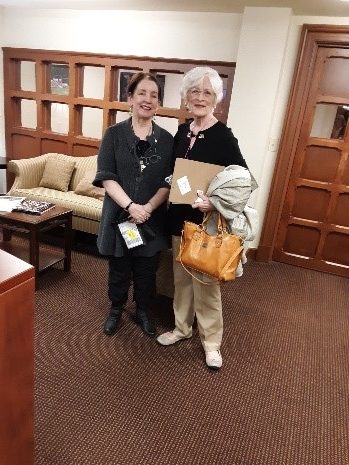
Mary Job and Jean Morris
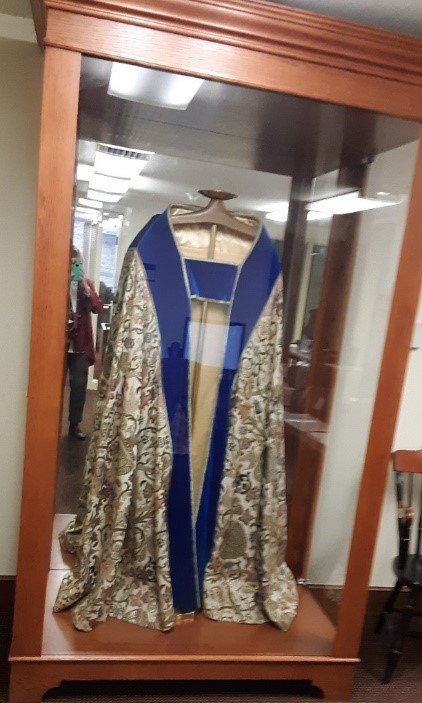
Vestments of Bishop Judson Child
“These are Bishop Child’s vestments,” said Mary. “He is the bishop that confirmed me.“
“And I voted for him to be bishop,” said Jean. “Three of us came from St. John’s as representatives of our parish. He was a most charming man.”
Charles Judson Child was born on April 25 1923, and died on January 5 2004. The seventh bishop of the Episcopal Diocese of Atlanta, he served from 1983 to 1989 (Wikipedia). Bishop Child is memorialized in several ways around the cathedral. For instance, the largest meeting room, formerly the Hall of Bishops, is called Child Hall.
“Now you know the Bishop is over us [the St. Philip’s congregation] as well as you at St. Paul’s since St. Philip’s is also a parish,” said Jean. “Congregations appoint search committees, conduct surveys, and read through applications, but it is the Bishop that approves priests and curates to serve parishes. They may or may not be the candidates chosen by the parish vestry and congregation. Also, the bishop sometimes recommends a curate who is looking for a job as an assistant.”
At this point, Mary Job became the tour guide, identifying the many offices within the Bishop’s suite. Then it hit me: this is the administrative area, or the nerve center, for the whole Diocese of Atlanta. It encompasses the Finance office, the office of Isaiah Rodriguez, a former Catholic monk who is Hispanic minister for St. Philip’s and a translator for the National Church; the office of Canon John, Canon for Ministry; the office of Easton Davis, Youth Commissioner for the Diocese; and the office of Bonnie Burgess, Canon for Administration and Finance.
I asked what a canon was. Mary explained that a canon is a member of Clergy who serves on the staff of the Diocese or Cathedral.
There is a row Bishops’ portraits on the wall outside of the Diocesan office, starting with the first Bishop of Atlanta and Bishop of Georgia before that, Cleland Kinloch Nelson, and ending with our present Bishop, Robert Christopher Wright. As these and other pictures show, the Diocese is really about what goes on inside and outside of the walls of the Cathedral.
“As the state of Georgia grew, there became too many parishes for one bishop to visit each of them at least once a year,” Jean explained. “So in 1907, the Diocese of Georgia split, and Cleland Nelson said, ‘I’m going to Atlanta!’ – not like that railroad man who left!”
Christ Church Cathedral in Savannah is still the cathedral for the Diocese of Georgia.
Jean added this historical anecdote. “In 1864, the Catholic priest Father O’Reilly told General Sherman he would excommunicate him and his entire army if he burned any church in Atlanta. Sherman knew that his Irish Catholic soldiers would rebel if this threat were carried out. So all four of the downtown churches were left intact.”
At this point we said goodbye to Mary and continued our tour. We passed the large children’s area, but it was locked, so I couldn’t get a good view to compare it with St. Paul’s new children’s wing. We passed the laundry room and met the fulltime laundress. Jean said that the altar linens and all those white tablecloths in the meeting rooms need frequent washings. We passed a print shop as well.
Then Jean showed me an attractive and comfortable room – the Gould room with sofas – used for meetings, lunches, and receptions. We also entered the glass- covered atrium that was once open with a fountain in the center. “But it was always dirty, so it went unused,” said Jean. “Now it is much more pleasant. The procession lines up here for services.”
At last we reach the nave, with its neogothic arches and gorgeous stained-glass windows. These are the Willett windows, installed in 1962 and donated by many different people.
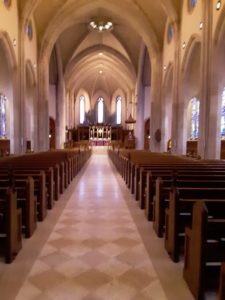
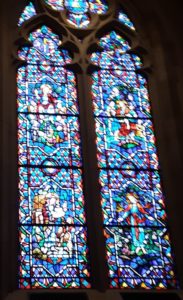 Nave of St. Philip’s Cathedral and one of its many magnificent stained-glass windows
Nave of St. Philip’s Cathedral and one of its many magnificent stained-glass windows
In contrast to the windows from the old church that St. Philip’s replaced, which depict a single Biblical story, each of these windows has multiple leaded panels that represent different characters, events, and parables from the Bible and from the later history of Christianity. Jean Morris knows the story of every panel. On the left wall (from the back of the nave) the windows portray New Testament stories, such as Jesus’ miracles. Just one window on that side represents Old Testament stories. Moses is portrayed with horns (the result of a mistranslation). A parishioner once commented that God applying hot coals to Isaiah’s mouth looked like a dentist. “I am a man of unclean lips,” said Isaiah, so God cleansed his mouth to make him fit for prophesy.
On the right side of the nave, the windows portray stories of the prophets as well as accounts from later Christian history. There is a window dedicated to the women of the Bible. And many more.
The Benedicte window over the nave entrance commemorates the plane crash in 1962 at Orly Field in France. “103 members of the Atlanta Art Association never made it back from their month-long tour of famed European art galleries. They were among the 130 people killed when Air France Flight 007 crashed off the end of an Orly Airport runway after an aborted takeoff attempt.” (AJC Archives).
Jean pointed out two small crosses that one might not notice otherwise. The Canterbury cross came from the Archbishop of Canterbury. It is made of rock left over from one of the many restorations of the Canterbury cathedral. The Cross of Nails is from Coventry Cathedral, which was bombed in World War II. The cross contains a speck from the Coventry nails. The practice of Foyers started in Coventry. When the cathedral was destroyed, the congregation met in each others’ homes.
Then we took a good look at the altar made of Italian marble. The kneeling pads around it are covered in cloth with needlepoint done by the Guild of St. Philip’s, which includes men as well as women. Beside the altar are the Dean’s chair and the Bishop’s chair, as well as chairs for the Canons.
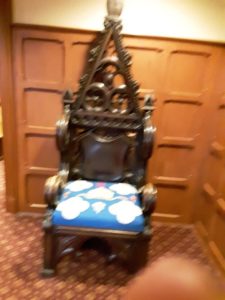
Bishop’s chair
Behind the altar is St. Philip’s magnificent Aeolian-Skinner organ. Musicians come from far and near to practice on it and give recitals. In fact, our own organist and choir director Mason Copeland gave a recital here a few years ago.
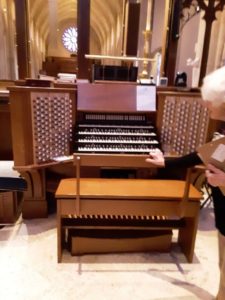
St. Philip’s organ
The organ console was replaced about ten years ago. It was financed over a three-year period with proceeds from the St. Philip’s Thrift Store. (Psst! Ladies, the address is 1893 Piedmont Rd NE, Atlanta, GA 30324. Jean says they have good stuff.) St Philip’s also sponsors an antique show, the proceeds of which go to charity, plus a Farmer’s Market that benefits folks on food stamps.
Then, at my request, Jean took me downstairs again to see the choir room. By the way, the men and women have separate vesting rooms! By chance, we met Timothy Gunter, coordinator of the entire music program, which includes scheduling the recitals and concerts and taking care of the choir library. Timothy is also a fine pianist. In fact, last summer he gave a series of free Beethoven recitals. Over several weeks, he managed to play half of the Beethoven piano sonatas. The other half are planned for this summer.

Timothy Gunter, Program Coordinator for Music
The bride’s room is underneath the narthex. A stairway allows her to make her way to the nave without being seen before she walks down the aisle.
Lastly, Jean took me to see Mikell Memorial Chapel, the oldest part of the church, opened in 1947 and unchanged since. It is dedicated to Bishop Mikell. Its stained-glass windows depict parables. Architects often meet here because they appreciate its perfect proportions.
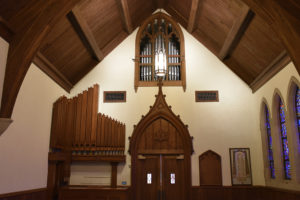 Mikell Chapel
Mikell Chapel
“This is a perfect place for a small funeral or a private wedding,” Jean remarked. The St. Philip’s 9:00 am service is held here every Sunday. Its small, elegant organ was given by a schoolteacher.
The tour ended as we took the elevator back to Child Hall, and then we returned to where we had begun. I thanked Ms Jean for a wonderful tour that deepened my appreciation for this magnificent structure. I strongly recommend that a group from St. Paul’s take her tour. St. Philip’s is a treasure, and so is she, for her knowledge and love of this place and the heritage it represents.
 St. Philip’s Cathedral (from Wikipedia)
St. Philip’s Cathedral (from Wikipedia)






 Mikell Chapel
Mikell Chapel